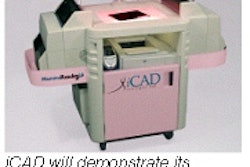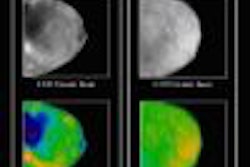CHICAGO – A team from Norway continue to find success with full-field digital mammography (FFDM). Dr. Per Skaane from Ulleval University Hospital in Oslo updated his group’s results, which compared FFDM soft-copy reading to traditional screen-film mammography in a population-based screening program.
At the 2001 RSNA, Skaane reported that mammographers preferred FFDM soft-copy reading as they gained more experience with it. Also, FFDM cut down on the reading time and increased patient throughput.
The current study population consisted of 25,855 women. Traditional mammography was performed in 10,895 women aged 50-69 and in 7,849 aged 45-49. FFDM was performed on 4,028 women aged 50-69 and in an additional 3,083 aged 45-49. Two standard views of each breast were acquired on a Mammomat 300 system (Siemens Medical Solutions, Erlangen, Germany) using a Min-R 2000 film processor (Eastman Kodak Health Imaging, Rochester, NY). Digital imaging was done on the Senographe 2000D (GE Medical Systems, Waukesha, WI).
More patients underwent screen-film mammography (70%) than FFDM (30%) because his institution has two Mammomat units and only one Senographe machine, Skaane explained.
Experienced mammographers, who used a 5-point scale of cancer probability, interpreted all of the exams. For the first six months, the FFDM exams were double-read, although the official report was based only on the reading of the two main radiologists.
The cancer detection rate and the positive predictive values (PPV) were compared for the two age groups, Skaane said.
A total of 119 cancers were detected, with screen-film pinpointing 75 for a detection rate of 0.42%. FFDM found 44 cancers for a detection rate of 0.61%. Broken down by age, the following cancer detection rates were reported: For ages 50-69 years, screen-film came in at 0.52% and FFDM at 0.79%; for ages 45-49, 0.22% for screen-film and 0.23% for FFDM.
In the 50-69 age group, the higher cancer detection rate on FFDM almost reached statistical significance (p= 0.056), Skaane said. The most commonly detected types of cancer were invasive cancer and ductal carcinoma in situ (DCIS).
The PPV based on abnormal screening exams was 8.9% for screen-film and 2.6% for FFDM in the 50-69 age group. In the 45-49 age group, the PPV was 3.6% for screen-film and 2.6% for FFDM.
In the older group of women, soft-copy reading of FFDM exams showed a higher cancer detection rate than screen-film mammography, Skaane concluded. In the younger age group, the two methods were comparable, which Skaane said makes “FFDM with soft-copy reading suitable for breast cancer screening.”
By Shalmali Pal
AuntMinnie.com staff writer
December 1, 2002
With experience, readers prefer full-field digital mammo, November 26, 2001
Copyright © 2002 AuntMinnie.com



















